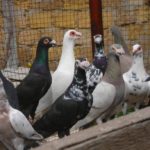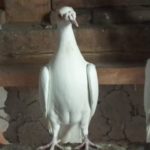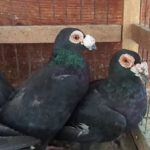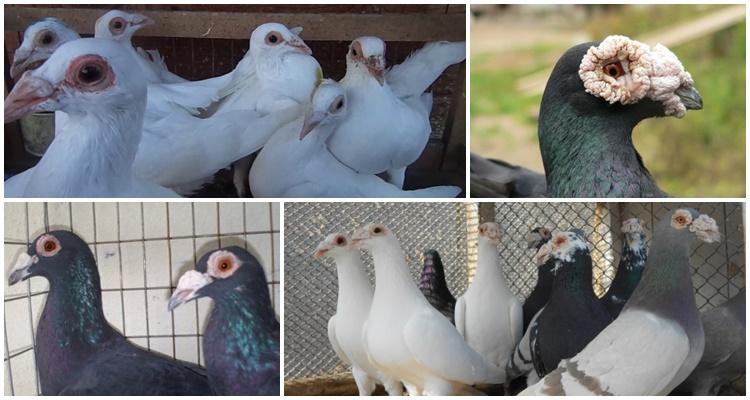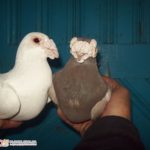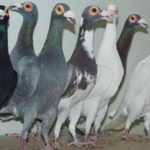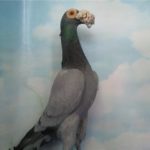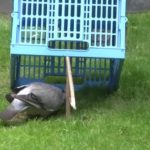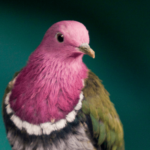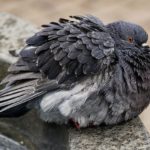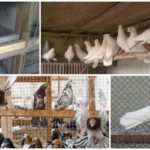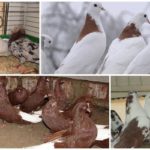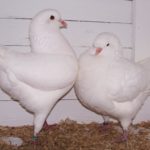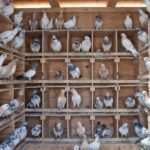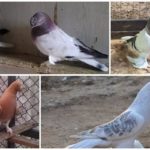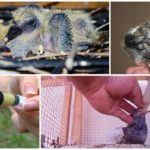At a time when pigeon mail was one of the means of communication, flying birds capable of accurately finding a home were of particular value. The dragon pigeon, a sporting type, was bred to deliver letters and participate in bird competitions for distance and speed of flight. Today, the colorful bird, which breeders willingly display at exhibitions and competitions, has acquired a decorative purpose.
Description and characteristics
The dragon pigeon is distinguished by a number of characteristic features, thanks to which the species is easily recognizable.Birds have an elongated, strong, muscular body with a well-developed chest. The oval head with a rounded crown smoothly transitions into a strong, medium-length neck, widening towards the bottom.
The pigeon's elongated legs have densely feathered, muscular shins. Wings with smooth, hard feathers are located on the sides of the body. The plumage of dragons can have different colors:
- white;
- black;
- gray-blue;
- Navy blue;
- yellow;
- brick red;
- light red.
The main distinguishing feature of dragons is the pronounced thickened cere above the beak of the pigeon and around the eyes. The degree of development of thickened skin formation depends on the subspecies of bird. There are 2 types of dragon pigeons - the large London one with a prominent openwork cere and the more sporty-looking Birmingham one with a less bushy, tight-fitting fold of skin on the beak and eye sockets.
Dragon pigeons are active and mobile, which is especially true for males, who often come into conflict with each other. The reason for the aggressive behavior of birds is also hunger or thirst. The fighting spirit often becomes the reason for hostile birds settling into separate cells. Females are more peaceful, calm and less likely to cause trouble to their owner.
Advantages and disadvantages
Dragon pigeons are of interest to breeders; they have a number of advantages and disadvantages due to the characteristics of the birds’ physiology and temperament.
The advantage of dragon females is considered to be a developed maternal instinct. Doves willingly breed and take care of the chicks.
Requirements for keeping racing pigeons
The pigeon house should be spacious and warm, with plenty of places for the birds to rest in the upper part of the room. To protect against cold winds, the walls of the dovecote are insulated, eliminating drafts and dampness. For females, wooden or wicker nests are made with sides up to 15 centimeters high.
One of the main conditions for keeping dragons is daily physical activity. Sporting breeds of pigeons must fly a lot, regardless of the weather and season. For training, an area with a mesh base is set up near the dovecote for birds to walk in the cold season.
What to feed the birds?
The question of the diet of dragons requires a careful approach. Pigeons have an excellent appetite, which, combined with a lack of physical activity, often becomes the cause of obesity. The basis of the diet of pigeons is:
- grains (wheat, barley, millet, corn);
- legumes (peas, lentils);
- oilseeds (sunflower seeds, rapeseed, hemp).
The daily grain requirement for an adult pigeon is 40-50 grams. Legumes contain vegetable protein, and oilseeds contain fats, the amount of which should not exceed 20% of the total feed volume.
For harmonious development and prevention of diseases, the diet of dragon pigeons must contain vitamins A, E, D, and group B.To prevent hypovitaminosis, fish oil and vitamin preparations are added to the feed.
The optimal solution is to use ready-made balanced feeds containing the necessary nutrients, vitamins and minerals to feed dragons. Pigeons must always have access to clean water. To prevent birds from knocking over water containers, special drinking bowls are installed.
Diseases of dragon pigeons
Under unfavorable conditions, poultry become vulnerable to various infectious diseases and parasitic infestations. Infectious pigeon diseases, which are caused by bacteria and viruses, are considered dangerous and contagious. Diseases quickly spread to the flock, and sometimes to humans, and require timely treatment.
Pigeons are susceptible to the following diseases:
- Psittacosis. It manifests itself as a change in the shape of the eyes, the color of the iris, lacrimation, shortness of breath and wheezing, rhinitis, diarrhea, and paralysis of the body.
- Smallpox is a viral disease. Characterized by apathy, breathing problems, discharge from the eyes and nose, red spots on the skin, and bald patches.
- Whirling disease (Newcastle disease, pseudoplague). The bird spins in place, falls on its side, or sits disheveled and ruffled.
- Salmonellosis is a contagious disease that occurs in various forms (latent, intestinal, articular, overt, nervous).
- Coccidiosis (caused by protozoa). It manifests itself as a ruffled pigeon, drowsiness, bloody diarrhea, loss of coordination, reduction in head size, and paralysis.
- Helminthic infestations.
- Aspergillosis (fungal infection).
- Tuberculosis (transmitted to humans).
Young animals are most vulnerable to diseases. To avoid the spread of diseases, it is necessary to monitor the cleanliness of the dovecote, process feeders and drinkers in a timely manner, and regularly inspect the birds.

